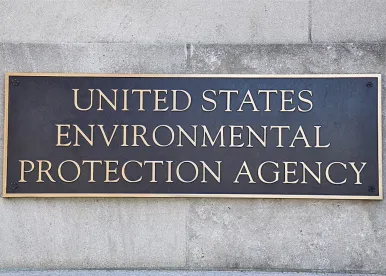The United States Environmental Protection Agency ("EPA") adopted an updated standard of practice for Phase I Environmental Site Assessments on December 15, 2022. The updated standard adds more refined investigation and reporting requirements for parties seeking protection from environmental liability in land transactions.
EPA took final action to amend the Standards and Practices for All Appropriate Inquiries ("AAI Rule"), which is widely used in real property due diligence investigations. The amendment adopts updates that ASTM International recently made to its standard of practice, E1527–21, entitled "Standard Practice for Environmental Site Assessments: Phase I Environmental Site Assessment Process." EPA's adoption allows voluntary use of ASTM's updated standard to satisfy the requirements for conducting all appropriate inquiries under the Comprehensive Environmental Response, Compensation, and Liability Act ("CERCLA").
In March 2022, the EPA issued—and then withdrew—a rule adopting the new standard for parties purchasing real estate, which would allow purchasers to be eligible for certain landowner liability protections under CERCLA. Nine months later, the EPA finally accepted ASTM E1527-21 as complying with the AAI Rule and replacing ASTM E1527-013 as of February 13, 2023. So what does it all mean?
How Did We Get Here?
CERCLA imposes strict cleanup liability on owners of property contaminated by hazardous substances; however, protection from such liability is available. In 1986, Congress created "innocent purchaser" defenses to CERCLA liability for parties acquiring contaminated property by inheritance or bequest and for innocent purchasers who did not know, and had no reason to know, the property was contaminated before purchase.
In 2002, Congress amended CERCLA again, this time through the Small Business Liability Relief and Brownfields Revitalization Act. The Act provides additional defenses for: (1) property owners whose land is contaminated by a release from, and is contiguous to, the source property owned by another; and (2) bona fide prospective purchasers ("BFPPs") who buy or lease property with knowledge of the contamination by the identification of certain environmental conditions. For innocent purchasers, contiguous property owners, and BFPPs to benefit from the liability protections, they must satisfy requirements for conducting an AAI investigation.
In 2005, EPA published the AAI Rule. The AAI Rule officially recognized the then-current version of the ASTM standard practice for conducting Phase I Environmental Site Assessments ("Phase I"), ASTM E1527-05, as sufficient to satisfy the CERCLA innocent purchaser defense.
What Is A Phase I?
Phase I refers to the investigation, analysis, and written report by the environmental professional who conducts AAI to ascertain whether there are risks of environmental contamination at the property.
To satisfy the AAI Rule, a Phase I must include: interviews with persons familiar with the property, preferably the current owner; analysis of historical information regarding the use of the property; searches for environmental cleanup liens; review of waste disposal, underground storage tank, and hazardous waste records, including file records of the various Divisions of the North Carolina Department of Environment Quality ("NCDEQ"); visual inspection of the property and adjoining properties; discussion of the presence of any recognized environmental conditions ("REC") at the property; and analysis of the ability to detect suspected contamination by follow-up investigation (known as a Phase II).
Since cleanup costs can frequently exceed the value of the contaminated property, lenders of investors in commercial real estate transactions often require a Phase I that meets the AAI Rule to satisfy due diligence requirements.
ASTM E1527-13 upgraded the identification and analysis required of Phase I reports by ASTM E1527-05 by supplementing the types of RECs and adding identification of risks to indoor air quality. As defined in ASTM E1527-13, an REC is "the presence or likely presence of any hazardous substances or petroleum products in, on, or at a property (1) due to a release to the environment; (2) under conditions indicative of a release to the environment; or, (3) under conditions that pose a material threat of future release." Releases that migrate in the subsurface of the property or soils through vapor pathways from other contaminated properties to indoor spaces also are considered an REC.
In addition, there are historical and controlled RECs. Historical RECs are past releases of hazardous substances remediated to meet unrestricted residential use criteria established by a regulatory authority, such as NCDEQ, without subjecting the property to any required controls. Controlled RECs are those that are not fully remediated, but have received risk-based regulatory closure with contaminants allowed to remain in place under certain conditions— such as institutional controls, land use restrictions, or restrictive covenants.
ASTM E1527-21 provides another round of upgrades to the content of a Phase I. It requires enhanced site investigations and research into the history of the site and adjoining properties; creates a new category for significant data gaps that may affect the environmental professional's conclusions; and clarifies the expiration of a Phase I Report. It updates the definition of REC by specifying when the "likely presence" of a release should be identified as an REC. And it clarifies that HRECs and CRECs are only those that affect the property and that current regulatory standards should be considered to determine whether the controls are sufficient.
Notably, the 2021 standard also addresses emerging contaminants, such as per– and polyfluoroalkyl substances (also known as PFAS). The GenX chemical found in the Cape Fear River, which was not defined as a hazardous substance under CERCLA when ASTM published E1527-21, is an example of a PFAS familiar to North Carolinians.
Although the presence or release of emerging contaminants are considered non-scope and not required to be addressed in a Phase I, they may be regulated under state law and likely will be federally regulated in the future. The user, whether a purchaser or a lender, can request the environmental professional conducting the Phase I to include such substances in the defined scope of work for the Phase I. If or when such emerging contaminants are defined to be a hazardous substance under CERCLA, as interpreted by EPA regulations and the courts, such substances will need to be evaluated.
"13" vs. "21"—Which to Use?
The 2013 and 2021 standards are relatively comparable, and both currently satisfy the AAI Rule to avoid liability for environmental contamination. Thus, purchasers should evaluate which standard to use from transactional and liability protection perspectives. The context, the intended use of the property, and the presence or absence of a lender are factors to be considered in choosing a standard. But because the EPA will sunset the 2013 standard on February 13, 2024, purchasers are well-advised to use and develop familiarity with the 2021 standard.
Overall, the EPA's acceptance of the 2021 standard to satisfy the AAI Rule is not likely to significantly affect environmental due diligence immediately. A Phase I still is not an exhaustive environmental investigation of the property—it will not identify compliance issues because there is no soil or groundwater sampling, and wetlands, asbestos, mold, and other risks are outside its scope. It also is not the appropriate standard for large tracts of forestland or rural property (for which AAI is met under ASTM E2247-16).
However, conducting a Phase I using the 2021 standard should provide BFPP liability protections by clarifying and providing additional guidance as to whether: (1) an REC is present at a property; or (2) there are conditions indicating a likely release of hazardous substances that might arise because of conditions on neighboring properties. ASTM E1527-21 brings clarity to many key AAI terms as well as the six-month shelf life of the Phase I report, and its use will result in a stronger assessment overall.
Conclusion
The EPA will accept both the 2013 and 2021 standards as meeting the AAI Rule through February 13, 2024. Until then, buyers should carefully consider whether conducting a Phase I under the more comprehensive ASTM E1527-21 standard is appropriate or desirable under the deal-specific circumstances of their commercial real estate transaction.
Discussing the new ASTM standard with environmental professionals will help to ensure proper identification of RECs and will allow environmental attorneys to negotiate as much protection from cleanup liability as possible during contract discussions.





 />i
/>i

